
On MAY 24, 2023
Complete Guide to Creating A Successful Customer Service Chatbot
Significant breakthroughs in technology have completely changed every aspect of our daily life, especially how to elevate digital customer experience and satisfy customer needs. Instead of managing an enormous sales team to answer hundreds of frequently asked questions, businesses nowadays leverage the power of customer self-service, which includes customer service chatbot to address consumers' issues in seconds.
Chatbot has become a familiar term for both business owners and customers thanks to its versatility, cost-effectiveness and round-the-clock availability. Apparently, the robustness of chatbots for customer service is unchallenged.
To make sure that every business can make full use of a chatbot, in this article, we will walk you through:
- A comprehensive definition of customer service chatbot,
- Key features of a chatbot,
- When to use customer service bots,
- Advantages and disadvantages of AI customer service chatbot,
- Guide to creating a chatbot with ease,
- FAQs about sales chatbot.
Let's get the ball rolling!
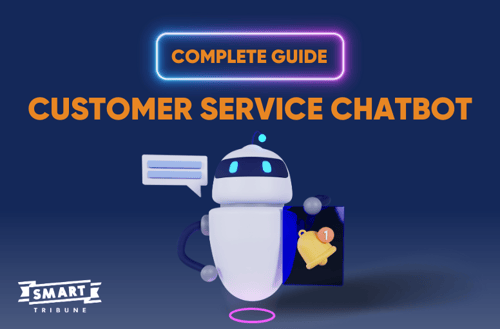
What is A Customer Service Chatbot?
First thing first, let's get down to the nitty-gritty of customer service chatbot.
What is Chatbot for Customer Service?
A chatbot for customer service is a software program or application that is specifically designed to interact with customers and provide support or assistance. It is deployed on platforms such as websites, messaging apps, or mobile apps, enabling customers to engage in text-based or voice-based conversations.
The primary purpose of a customer service chatbot is to automate and streamline customer interactions, yielding quick and efficient responses to common inquiries or problems. Instead of having to wait for a human agent, customers can interact with the chatbot in real-time, receiving immediate assistance.
A customer service chatbot can handle a wide range of tasks, including:
1. Answering frequently asked questions: An automated bot can deliver instant responses to common queries related to product information, pricing, shipping, returns, and more. By accessing a knowledge base or predefined set of responses, a help desk chatbot can immediately give customers accurate and consistent information.
2. Troubleshooting: Live chatbots can walk customers through basic troubleshooting steps for technical issues, product malfunctions, or software glitches. They can offer step-by-step instructions or suggest solutions based on the customer's description of the problem.
3. Order tracking and status updating: Customers can inquire about the status of their orders, request tracking information, or modify their orders using a chatbot. eCommerce chatbots can access the relevant databases or systems to provide real-time updates.
4. Appointment scheduling: Chatbots can assist customers in booking appointments, making reservations, or arranging service visits. Best chatbots for customer service can access availability calendars, show options, and finalize bookings.
5. Gathering feedback and complaints: Chatbots can collect customer feedback, suggestions, or complaints, allowing businesses to gather valuable insights. They can also escalate complex or urgent issues to a human sales representative for resolution.
6. Personalizing recommendations: Advanced sales chatbots can analyze customer data and purchase history to offer personalized product recommendations or suggest relevant offers. 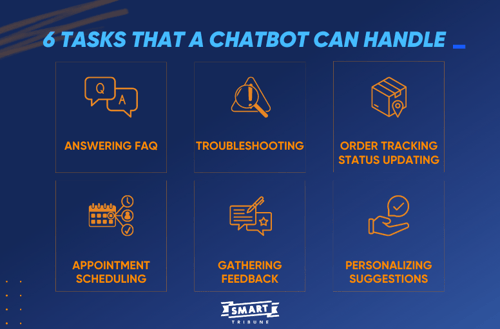
Customer service chatbots leverage technologies such as natural language processing (NLP) and machine learning to understand customer queries, generate appropriate responses, and improve their performance over time. They aim to enhance the customer experience, increase efficiency, and reduce the workload on human customer service representatives.
To delve deeper into customer service chatbot, here comes an insights hub for you:
- 6 Problems A Chatbot Can Solve
- Secret Revealation of Lead Generation Chatbot
- Chatbot Marketing 101 - Guide for Beginners
What are Types of Chatbot For Support?
There exist several types of customer service bots based on their functionality and design. Here are some common types:
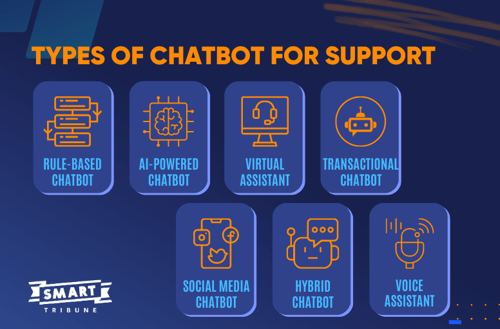
1. Rule-based chatbots: Rule-based chatbots operate on a predefined set of rules and responses. They follow a decision tree or flowchart structure to give answers based on specific keywords or patterns in customer queries. Rule-based chatbots are typically limited in their capabilities and require manual updating when new rules or responses need to be added.
2. AI-powered chatbots: AI-powered chatbots utilize artificial intelligence and machine learning techniques to understand and respond to customer queries. AI customer service chatbot exploits natural language processing (NLP) algorithms to interpret and extract meaning from text or voice inputs. AI chatbots can learn from interactions, sharpen their responses over time, and handle more complex conversations.
3. Virtual assistants: Virtual assistants are advanced chatbots that can perform a wide range of tasks beyond customer service. They are designed to emulate human-like conversations and can undertake sophisticated tasks such as scheduling appointments, answering queries, providing personalized recommendations, controlling smart devices, and more. Virtual assistants often have a broader scope and are capable of integrating with various systems and services.
4. Transactional chatbots: Transactional chatbots focus on facilitating transactions or performing specific actions. They are commonly used in e-commerce or banking environments to help customers with purchases, make reservations, process payments, check account balances, or perform other transactional tasks. These chatbots are designed to guide customers through the transaction process and give them a hand if needed.
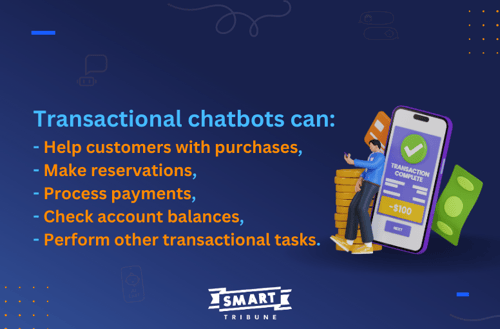
5. Social media chatbots: Social media chatbots are specifically designed for interaction on social media platforms. They can engage with customers on channels like Facebook Messenger, WhatsApp, Twitter, or Instagram. Social media chatbots are used for various purposes, including customer support, lead generation, content distribution, and personalized messaging.
6. Hybrid chatbots: Hybrid chatbots combine rule-based and AI-powered approaches. They deploy predefined rules for handling common queries and fall back to AI techniques for handling more complex or ambiguous requests. Hybrid chatbots cater a balance between scalability and flexibility.
7. Voice assistants: Voice assistants, also known as voice-activated chatbots, interact with users through voice commands and responses. They are commonly found in devices like smart speakers, smartphones, or in-car systems. Voice assistants utilize speech recognition technology to understand user commands and provide voice-based responses or perform actions.
Basically, these are some of the main types of chatbots, and there can be variations or combinations based on specific chatbot use cases and requirements. The type of chatbot chosen depends on the desired functionality, complexity of interactions, and the goals of the organization implementing it.
What is A Chatbot Message?
A chatbot message refers to a piece of text or response generated by a chatbot in a conversation with a user. When a visitor interacts with a chatbot, they type in a message or a question, and the chatbot analyzes the input and generates a relevant reply. 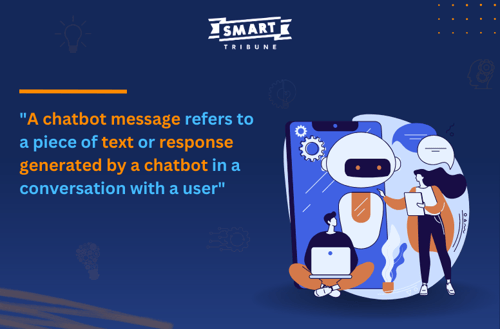
For example, if a user inquires about weather information, the chatbot may generate a message such as: "The current temperature is 25 degrees Celsius with partly cloudy skies. There's a chance of rain later in the day."
What are Features of A Customer Service Chatbot?
Chatbot features can vary depending on the specific chatbot implementation and its intended purpose. However, at the core of common chatbot features are:
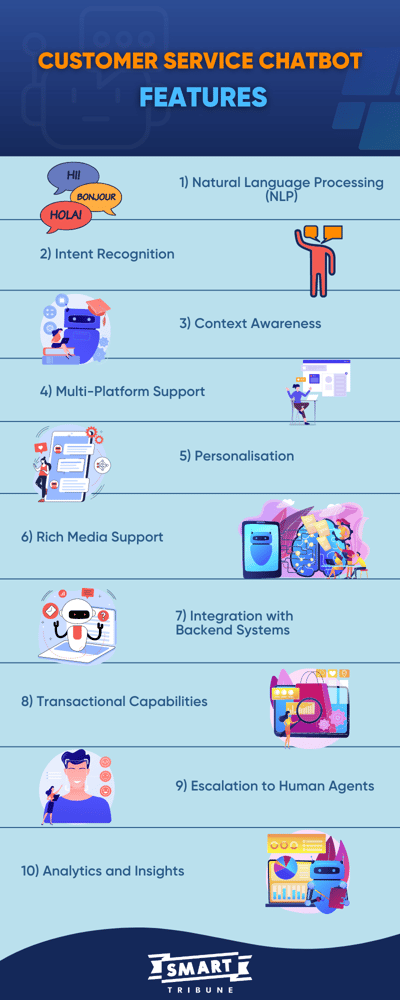
1. Natural Language Processing (NLP): Chatbots that are armed with NLP capabilities can understand and interpret user inputs in natural language, allowing for more conversational and intuitive interactions. To some extent, this attribute makes a chatbot more human and friendlier to your audiences.
2. Intent Recognition: Bots can identify the intent behind user messages, determining the purpose or goal of the user's query. This enables the chatbot to provide appropriate responses or take relevant actions.
3. Context Awareness: A chatbot equipped with this functionality shows exceptional potential and capability in maintaining context throughout a conversation. The chatbot records all of the previous interactions and analyzes that information to respond in a more personalized and relevant manner.
4. Multi-Platform Support: Since different users utilize different channels to communicate and interact with brands, a chatbot should operate without hiccups on various platforms to ensure a consistent user experience. They can be designed to work well on websites, messaging apps, social media platforms, or voice-enabled devices.
5. Personalisation: Chatbots can leverage user data and preferences to offer personalised recommendations, suggestions, or tailored responses. This enhances the user experience and provides a more individualised interaction.
6. Rich Media Support: To satisfy a user's expectation of richer and more engaging conversations, some chatbots can handle various types of media, such as images, videos, audio files, or interactive elements.
Find out more about What customers really think about a chatbot
7. Integration with Backend Systems: Chatbots can integrate with existing databases, APIs, or backend systems to access and retrieve information required to respond to user queries or perform actions. This enables chatbots to provide real-time data or associate with other services.
8. Transactional Capabilities: Several advanced chatbots are developed with transactional features, allowing users to perform actions such as making purchases, bookings, or payments directly within the chatbot interface.
9. Escalation to Human Agents: In some cases, a chatbot cannot adequately address a user's query or when a more personalized human touch is required, the chatbot can seamlessly escalate the conversation to a human customer service representative.
10. Analytics and Insights: Chatbots can generate reports and analytics on user interactions, allowing businesses to gain insights into customer preferences, frequently asked questions, or rooms for improvement.
These above features are not exhaustive, and chatbots can have additional functionalities based on particular needs. Apparently, the features of a chatbot play a crucial role in determining its effectiveness, user satisfaction, and the value it provides to businesses or users.
What is Chatbot Used For?
With the groundbreaking advancement that customer self-service can bring to a brand and a plethora of users, chatbots are now being deployed for a wide range of purposes across various industries and domains. Some common use cases for chatbots include:
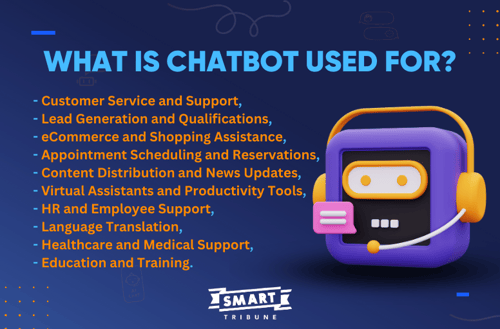
1. Customer Service and Support: Chatbots are universally used to provide 24/7 customer support, answer frequently asked questions, assist with product inquiries, troubleshoot issues, and handle customer complaints. They can provide instant responses, reduce wait times, and enhance customer satisfaction.
Learn more: How to make your website customer self-service friendly
2. Lead Generation and Qualification: A regular customer service chatbot can engage with website visitors or social media users to collect information, qualify leads, and guide them through the sales process. A bot can also capture user information, provide product recommendations, and assist in scheduling appointments or demos.
3. eCommerce and Shopping Assistance: eCommerce chatbot can offer personalized shopping experiences, help users find products based on their preferences, provide recommendations, and facilitate the purchase process. They can also handle order tracking, returns, and inquiries related to shipping or billing.
4. Appointment Scheduling and Reservations: Chatbots can automate the process of scheduling appointments, making reservations for restaurants, hotels, or services. Without any manual interference, they can check availability, provide options, and finalize bookings for customers.
5. Content Distribution and News Updates: Chatbots can deliver personalized news updates, weather forecasts, or relevant content to users based on their interests, preferences and locations. News and updates may seem irrelevant to your brand, this sort of customer service chatbot, however, can gradually win customer loyalty as timely information is always appreciated.
6. Virtual Assistants and Productivity Tools: Chatbots can act as virtual assistants, which help users with tasks such as setting reminders, managing calendars, and providing access to information or resources.
7. HR and Employee Support: Chatbots can assist employees with HR-related inquiries, such as leave requests, policy information, onboarding processes, or providing access to company resources.
8. Language Translation: Chatbots equipped with language translation capabilities can support users to communicate and translate text or speech in real-time. Immediate translation of a customer service chatbot can make a substantial contribution to overcoming language barriers and enabling global interactions.
9. Healthcare and Medical Support: Surprisingly, in the healthcare domain, a chatbot can offer basic medical advice, provide information about symptoms or conditions, schedule appointments with doctors, and assist in medication management. Besides chatbot, medical institutes can also leverage other technologies to, such as Kareo billing software or KanTime health, to boost productivity.
10. Education and Training: The robustness of chatbots also contributes to positive change in education. A chatbot can serve as a virtual tutor that can provide educational resources, answer questions, and guide students through various topics or learning materials.
These are just a few examples of how chatbots are used, and the applications continue to expand as technology advances.
With deep insights into each industry and rich experience in building chatbot systems for juggernauts, Smart Bot has won more than 150 key clients, who specialise in diverse domains, such as Agriculture, Automotive, Banking, Entertainment, Fashion & Luxury, NGO, Real Estate, Software, Hobbies, Technology, Transportation and more.
Chatbots offer automation, efficiency, scalability, and improved user experiences in a great number of industries, making them valuable tools for businesses and users alike. Especially, with a one-stop chatbot service like Smart Bot by Smart Tribune, the whole process of designing, developing, deploying and maintaining a feature-rich chatbot is just a breeze.
Pros and Cons of Customer Service Bots
Evidently, the prosperity of customer service chatbot has facilitated the support process for millions of brands and helped them reach more goals of elevating customer satisfaction, increasing customer retention and earning brand trust.
The latest statistics show that over 55% of B2B businesses and 42% of B2C companies are harnessing chatbots on their websites, social platforms and apps to upgrade customer experience.
These figures indicate that the advantages that customer service chatbot brings to the table are unchallenged. Let's uncover the secrets of why a myriad of brands has placed their faith in a chatbot!
Benefits of Chatbot for Customer Service
Chatbots bring numerous benefits to customer service operations. Some enormous advantages of using chatbots for customer service that are worth mentioning are: 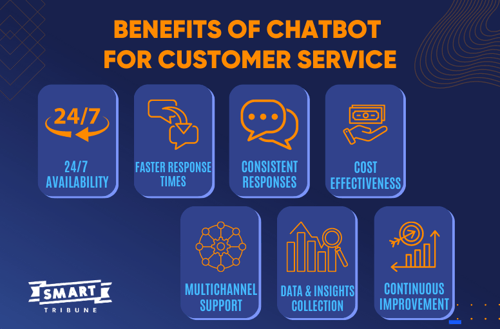
1. Round-the-clock Availability: Typically, chatbots can normally run 24/7 to instantly support your customers regardless of the time of day. This ensures that your prospects or consumers can receive immediate assistance and information whenever they need it. Obviously, timely assistance will radically improve customer satisfaction.
2. Faster Response Times: Chatbots can provide immediate responses to customer inquiries, eliminating the need for customers to wait in queues or for a human sales representative. Troubleshooting customer issues quickly will reduce their frustration and build brand fanocracy.
3. Consistent and Accurate Responses: While different sales agents show different styles in responding to customers' queries, chatbots provide consistent and accurate information to customers. Since a chatbot is developed by IT engineers, it offers the same standardised level of support. By accessing predefined knowledge bases or rules, customer service bots deliver reliable responses, reducing the risk of human error or inconsistencies.
4. Cost-Effectiveness: Brands can get more bang for their buck as chatbots can significantly reduce operational costs for customer service departments. Once implemented, both AI chatbots and rule-based chatbots will handle a large volume of inquiries without a hitch and the need for additional human agents. Bots are exceedingly cost-saving for businesses with high customer interaction volumes.
5. Multichannel Support: Chatbots can be deployed across multiple platforms and channels, including websites, messaging apps, social media, or voice-enabled devices. This allows businesses to provide consistent support and engagement regardless of the customer's preferred communication channel.
6. Data and Insights Collection: Chatbots can collect valuable customer data and insights during interactions, such as customer preferences, frequently asked questions, or areas where customers encounter difficulties. This data can be used to further boost products, services, and customer experiences.
7. Continuous Learning and Improvement: AI-powered chatbots can learn from customer interactions, continuously improving their responses and performance over time. They can adapt to customer preferences, identify trends, and refine their capabilities, resulting in more effective and personalized customer service.
These aforementioned benefits emphasize the huge advantages that chatbots bring to customer service operations, enabling your business to deliver efficient, consistent, and satisfactory support to your customers.
Limitations of Chabot in Customer Service
While chatbots offer numerous benefits, they also have certain limitations in the account of customer service. Various disadvantages of a chatbot that you should keep in mind to overcome are:
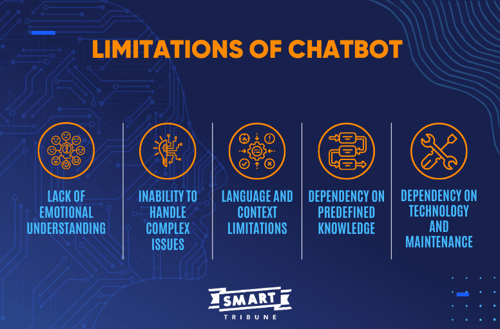
1. Lack of Emotional Understanding: Chatbots may struggle to comprehend and respond appropriately to emotions expressed by customers. Even the most advanced chatbots with AI capability may not be able to pick up on frustration, anger, or sarcasm in customer messages, potentially leading to misinterpretations and inadequate responses.
2. Inability to Handle Complex Issues: While chatbots can effectively handle familiar and straightforward inquiries, they may struggle with more complex or unique problems that require human intervention. Chatbots rely on predefined rules or algorithms, and they may not possess the ability to analyze complex scenarios or provide creative solutions.
3. Language and Context Limitations: Chatbots also face challenges in understanding and replying accurately to ambiguous or context-dependent queries. They can sometimes misinterpret user inputs, leading to incorrect or irrelevant responses. Additionally, language barriers, slang, or regional variations in language may pose challenges for chatbots that rely heavily on language processing algorithms.
4. Dependency on Predefined Knowledge: Chatbots operate based on predefined rules, databases, or knowledge bases. If the information they have access to is incomplete, outdated, or limited, it can result in inaccurate or inadequate responses to customer inquiries. Regular maintenance and updates are necessary to keep chatbots up-to-date and aligned with current information.
5. Dependency on Technology and Maintenance: Chatbots rely on technology infrastructure and software systems to function effectively. Technical issues, system failures, or updates can temporarily disrupt chatbot operations, leading to service interruptions and customer dissatisfaction. Regular maintenance and monitoring are necessary to ensure smooth functionality.
Despite these limitations, chatbots can still be a game changer for customer service when used appropriately. Combining chatbot capabilities with human support can help overcome these limitations and provide a more delightful customer experience.
As a matter of fact, the shortcomings of a chatbot can be improved or diminished by opting for a suitable chatbot provider. With Smart Tribune, you can steer clear of the downsides of a customer service chatbot as there will be assigned IT engineers who take full responsibility for the regular operation of your chatbot. This ensures that your chatbot will always run smoothly and be updated and maintained frequently.
How to Set Up A Phenomenal AI Customer Service Chatbot with Smart Tribune?
At Smart Tribune, we understand that creating a chatbot might be a daunting task as it involves both deep customer insights and technical knowledge. Therefore, to satisfy the most demanding users, we will walk you through 5 phases to successfully build a customer service chatbot with ease with Smart Bot. 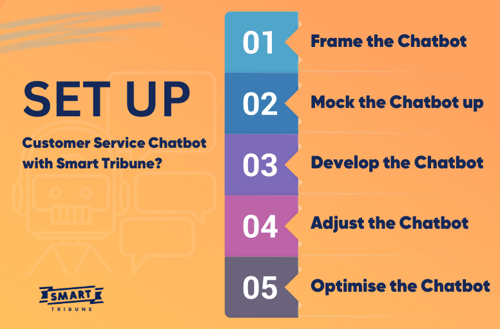
Phase 1: Frame the chatbot
This very first phase is of paramount importance to you and Smart Tribune because we will together discover the chatbot's functionality and how it solves your customer's problems.
Step 1: Determine your expectation.
In this initial stage, a project manager from Smart Tribune will have a meeting with you to learn more about your expectation for the chatbot.
First, you will have to determine all of the goals of the chatbot. It can probably be cutting customer support costs or reducing waiting time or even a more specific goal, which is to validate a customer's order.
By collecting your unique demands and defining the level of priority for each goal, Smart Tribune will illustrate them on a special spider chart. These specifications serve as a tactical primer for IT engineers to exactly build a customer service chatbot to your needs.
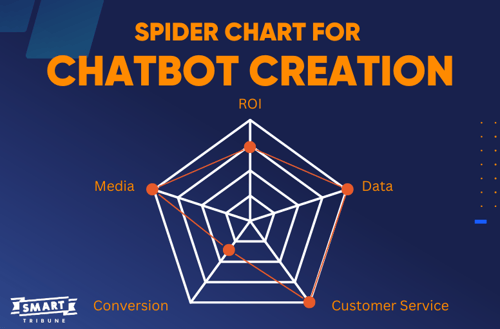
Step 2: Identify your target customers and their pain points
Throughout this step, you and the project manager will delve deep into what bothers your customer the most when they land on your website, social pages or app.
The goal of this step is to ensure that the chatbot solution is useful and friendly to your visitors. For instance, some common questions or topics should be mentioned to help the chatbot get a better grip on your customers.
Step 3: Dig deeper into customer experience
In order to elevate the customer experience, in this step, Smart Tribune will give you a hand in drawing the possible customer buying journey to find out the snarl-ups, customer emotions and questions they are likely to pose in each touch point.
These insights will be further analysed to make them input for your chatbot.
Step 4: Compare answers with the determined goals
After devoting a great deal of time and effort to the customer journey and their issues, you and the project manager will compare the solutions with the defined goals in the earlier step. Comparison and alignment are mandatory processes to ensure that the bot lives up to your expectation and help you to reach the ultimate goals.
Phase 2: Mock the chatbot up
From now on, Smart Tribune experts take full responsibility for tailoring a top-notch chatbot closely based on your customer portraits and your expectation.
In this phase, our IT developers will work hard to quickly deliver a demo of your chatbot to collect your feedback and make adjustments if needed.
Phase 3: Develop the chatbot function and design its interface
Highly-experienced developers from Smart Tribune team will cover this phase. Our experts prioritise the scalable back-end and dazzling front-end, and guarantee the most user-friendly interface for you and your customers.
At the same time, seasoned developers will leverage AI power to train the chatbot to ensure its robustness and intelligence.
One of the most fascinating tasks in this phase is that you can name your chatbot. Here is a comprehensive guide to finding a good bot name and 200+ industry-based chatbot name ideas.
Phase 4: Adjust the chatbot operation
According to Smart Tribune motto, a pixel-perfect customer service chatbot consists of 10% of well-structured code and 90% of appropriate content.
That's the reason why Smart Tribune retains customising content following your customer persona, your products and your services. This refining process enables the chatbot to address your customer pain points effectively.
Phase 5: Optimise the chatbot operation
After launching the chatbot for a certain amount of time, Smart Tribune analysts and developers will collaborate to optimise the performance of the chatbot based on the usage data.
Smart Tribune is in charge of optimising and maintaining your chatbot on a regular basis to assure the finest chatbot's performance.
FAQs about Bots for Customer Service
What is a chatbot?
Simply put, a chatbot is a computer program or an artificial intelligence (AI) system designed to interact with humans through text-based or voice-based conversations. Chatbots can use natural language processing (NLP) techniques to understand and analyze user questions and generate appropriate responses.
How can chatbots improve customer service?
A chatbot can enormously enhance customer service as it can provide consistent responses and experiences to the customer immediately whenever they need. Simultaneously, by constantly gathering data on customer usage and feedback, a customer service chatbot can deliver personalised recommendations, offers and improve its responses itself.
What is the best AI chatbot?
The best AI chatbot is the bot that can instantly give accurate answers and offer helpful support to customers.
How does a customer service chatbot work?
Basically, a chatbot collects users' input, analyses it and provides the most relevant answers based on its predefined database or machine learning process.
How to use chatbots?
With an eye-catching interface coupled with a scalable back-end designed and developed by experts from Smart Tribune, all businesses have to do to use the chatbot is to apply some lines of code to their existing system or platform. The chatbot will operate normally on different platforms.
That's A Wrap!
It's been a long journey with the customer service chatbot! There exists an emerging trend that B2B and B2C businesses have inclined toward chatbots to reduce the workload for sales representatives, maximize customer support capability, increase customer satisfaction, cut costs, and earn brand love.
Though you may have some concerns related to a bot, it's totally worth a try to reap the long-term benefits of this cutting-edge invention.
With the ever-evolving technology, chatbots have an essential role to play across industries, ranging from eCommerce, retail, agriculture to automotive, tourism, entertainment and beyond. If you haven't taken advantage of chatbot for your product or service, now it's time to stop imagining that you have one, set up a quick meeting with Smart Tribune to run a demo and see a revolutionary breakthrough yourself!

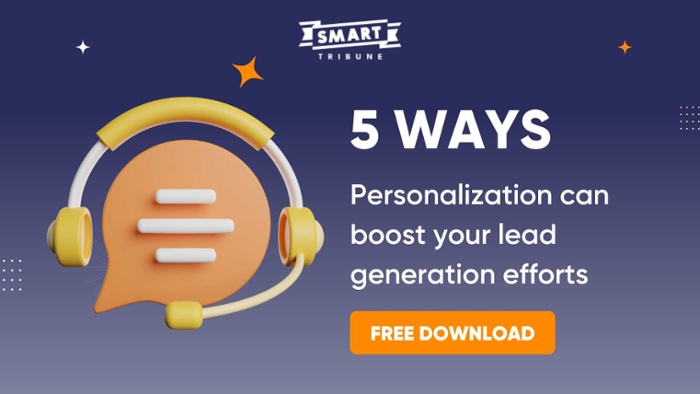

.png)



